4 classes of cnidarians - Study guides, Class notes & Summaries
Looking for the best study guides, study notes and summaries about 4 classes of cnidarians? On this page you'll find 9 study documents about 4 classes of cnidarians.
All 9 results
Sort by

-
CSCC Bio 1114 Exam 3 Questions and Answers Graded A 2024
- Exam (elaborations) • 10 pages • 2024
-
- $14.49
- + learn more
Phylum of Parazoa and etc - Porifera = pore bearing = sponges with no tissues Sessile adults, mostly marine Asymmetrical or Radial symmetry Sponge morphology voacb - spongocel, choanocytes, mesohyl, amoebocytes Spongocel, osculum, ostium - central cavity of the sponge, large opening, pores choanocytes - collared cells; flagellated, line the spongocel and beat in unison and move water towards the top osculum; water goes in through the pores with food that may or may not be good to eat ...

-
BROOKS BIODIVERSITY UNIT 3 EXAM | QUESTIONS & ANSWERS (VERIFIED) | LATEST UPDATE | GRADED A+
- Exam (elaborations) • 47 pages • 2024
-
- $15.99
- + learn more
1 BROOKS BIODIVERSITY UNIT 3 EXAM | QUESTIONS & ANSWERS (VERIFIED) | LATEST UPDATE | GRADED A+ Plants Architecture Correct Answer: Plant needs i. collection & conversion of solar energy -> leaves ii. positioning & support of leaves -> stems iii. anchorage & absorption -> roots iv. transport -> vascular system Leaf Structure Correct Answer: Epidermis, Mesophyll, and Vein (Vascular Bundle) Epidermis contains what? Correct Answer: - Cuticle - Guard cells with Stomata ...

-
Campbell Biology Chapter 33 Study Guide with Complete Solutions
- Exam (elaborations) • 13 pages • 2024
-
- $9.99
- + learn more
Campbell Biology Chapter 33 Study Guide with Complete Solutions Invertebrates - Answer️️ -Animals without a backbone. About 95% of known animal species. Calcarea and Silicea - Answer️️ -phylum that includes sponges; no symmetry, tissues, body cavity, organs, nervous system; basal animals; mostly marine; contain spicules; most are hermaphrodites; free-swimming during larval stage and sessile (non motile) as adults; suspension/filter feeders Suspention feeders - Answer️️ -small...
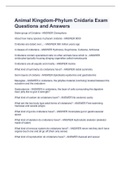
-
Animal Kingdom-Phylum Cnidaria Exam Questions and Answers
- Exam (elaborations) • 5 pages • 2022
-
- $9.99
- + learn more
Sister group of Cnidaria - ANSWER Ctenophora About how many species in phylum cnidaria - ANSWER 9000 Cnidarias are dated over... - ANSWER 580 million years ago 4 classes of cnidarians - ANSWER Hydrozoa, Scyphozoa, Cubozoa, Anthozoa Cnidarians contain specialized cells no other animals have which is - ANSWER cnidocytes-typically housing stinging organelles called namatocysts Cnidarians are all aquatic and mostly - ANSWER marine What kind of symmetry do cnidarians have? - ANSWER ...

-
BIO 207
- Class notes • 69 pages • 2022
-
- $14.99
- + learn more
NATIONAL OPEN UNIVERSITY OF NIGERIA COURSE CODE : BIO 207 COURSE TITLE: LOWER INVERTEBRATES Course Code & Course Title: BIO 207: Lower Invertebrates Course Writer: Dr. Patrick A. Audu Course Editor Programme Leader Dr. Ado Baba Ahmed National Open University of Nigeria, Lagos Course Coordinator Mr. Adams, Abiodun E National Open Univers...
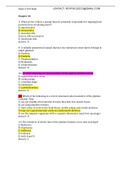
-
Exam 4 Test Bank
- Exam (elaborations) • 24 pages • 2022
-
- $10.49
- + learn more
1) What are the cells in a sponge that are primarily responsible for trapping food particles from circulating water? A) amoebocytes B) choanocytes C) mesohyl cells D) pore cells (porocytes) E) epidermal cells Answer: B 9) A radially symmetrical animal that has two embryonic tissue layers belongs to which phylum? A) Porifera B) Cnidaria C) Platyhelminthes D) Nematoda E) Echinodermata Answer: B 10) All of the following are characteristics of the phylum Cnidaria except A) a gastrovascular cavity. B...
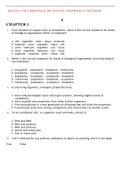
-
biology-essentials-3rd-hoefnagels-test-bank
- Exam (elaborations) • 43 pages • 2022
-
- $7.99
- + learn more
Detailed Contents UNIT 1 Science, Chemistry, and Cells Chapter 1 The Scientific Study of Life 1.1 What Is Life? A. Life Is Organized B. Life Requires Energy C. Life Maintains Internal Constancy D. Life Reproduces, Grows, and Develops E. Life Evolves 1.2 The Tree of Life Includes Three Main Branches 1.3 Scientists Study the Natural World A. The Scientific Method Has Multiple Interrelated Parts B. An Experimental Design Is a Careful Plan C. Theories Are Comprehensive Explanations D. ...
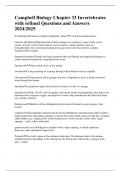
-
Exam (elaborations) Biology
- Exam (elaborations) • 8 pages • 2024
-
- $7.99
- + learn more
Invertebrates️️Animals without a backbone. About 95% of known animal species. Calcarea and Silicea️️phylum that includes sponges; no symmetry, tissues, body cavity, organs, nervous system; basal animals; mostly marine; contain spicules; most are hermaphrodites; free-swimming during larval stage and sessile (non motile) as adults; suspension/filter feeders Suspention feeders️️small and large organisms that use filtering and trapping techniques to collect minute food particles su...
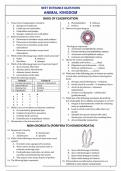
-
animal kingdom,animal classification,animal kingdom class 11,animal classification for kids,kingdom animalia,classification of animal kingdom,classification,kingdom animalia classification,animals,five kingdom classification,animal kingdom class 11 ncert,
- Summary • 6 pages • 2024
-
- $10.49
- + learn more
The animal kingdom is one of the major classifications in biological taxonomy, encompassing a vast diversity of organisms. Animals are typically categorized based on shared characteristics and evolutionary relationships. Here's a comprehensive overview of the animal kingdom classification: ### **Animal Kingdom Classification** #### **1. Domain and Kingdom** - **Domain**: Eukaryota - **Kingdom**: Animalia Animals are eukaryotic organisms, meaning their cells have a nucleus and other...

How much did you already spend on Stuvia? Imagine there are plenty more of you out there paying for study notes, but this time YOU are the seller. Ka-ching! Discover all about earning on Stuvia


